佛教文化考古 英文
- 格式:ppt
- 大小:6.96 MB
- 文档页数:59

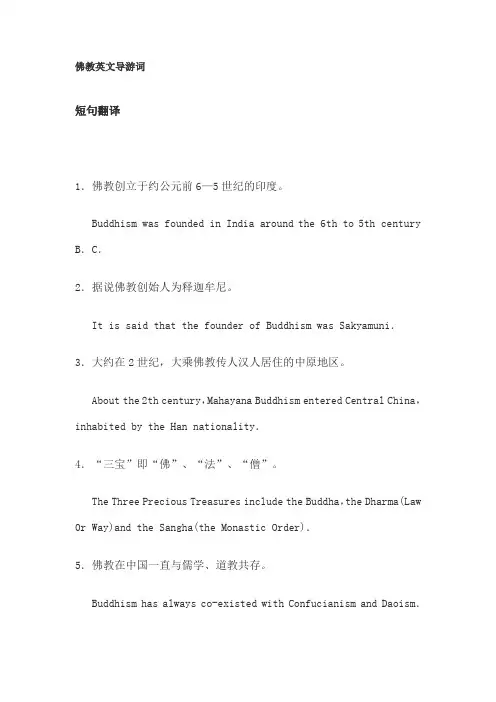
佛教英文导游词短句翻译1.佛教创立于约公元前6—5世纪的印度。
Buddhism was founded in India around the 6th to5th century B.C.2.据说佛教创始人为释迦牟尼。
It is said that the founder of Buddhism was Sakyamuni.3.大约在2世纪,大乘佛教传人汉人居住的中原地区。
About the2th century,Mahayana Buddhism entered Central China,inhabited by the Han nationality.4.“三宝”即“佛”、“法”、“僧”。
The Three Precious Treasures include the Buddha,the Dharma(Law 0r Way)and the Sangha(the Monastic Order).5.佛教在中国一直与儒学、道教共存。
Buddhism has always co-existed with Confucianism and Daoism.6.佛像和菩萨雕塑供奉在寺院里,让人们拜祭。
Buddhism has and Bodhisattva statues have been placed for worship in monasteries.长句翻译7.直到现在,小乘佛教仍然流行于傣族地区。
Up to the present time.Hinayana Buddhism(Lesser Vehicle)is still prevalent as in the regions inhabited by Dai nationality.8.传统之间相互共存促进了有中国特色的宗教的形成。
Their mutual co-existence of the tradition has produced a religion with distinct Chinese characteristics.9.同一个寺院里除释迦牟尼以外,还供奉了许多其他佛像和菩萨雕塑。
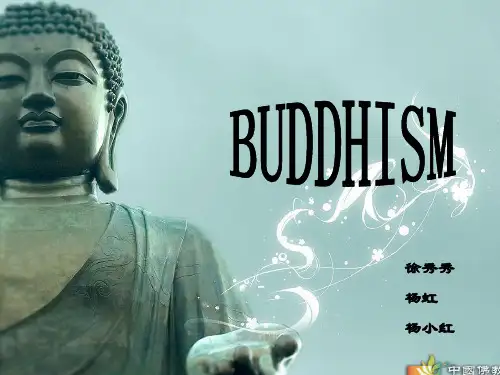
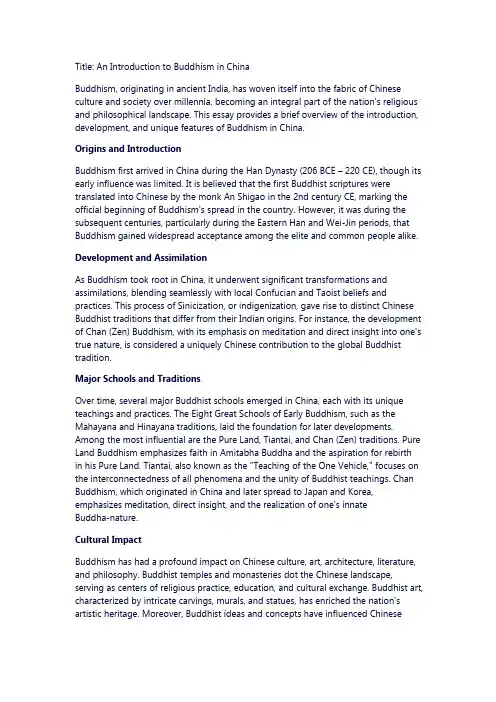
Title: An Introduction to Buddhism in ChinaBuddhism, originating in ancient India, has woven itself into the fabric of Chinese culture and society over millennia, becoming an integral part of the nation's religious and philosophical landscape. This essay provides a brief overview of the introduction, development, and unique features of Buddhism in China.Origins and IntroductionBuddhism first arrived in China during the Han Dynasty (206 BCE – 220 CE), though its early influence was limited. It is believed that the first Buddhist scriptures were translated into Chinese by the monk An Shigao in the 2nd century CE, marking the official beginning of Buddhism's spread in the country. However, it was during the subsequent centuries, particularly during the Eastern Han and Wei-Jin periods, that Buddhism gained widespread acceptance among the elite and common people alike. Development and AssimilationAs Buddhism took root in China, it underwent significant transformations and assimilations, blending seamlessly with local Confucian and Taoist beliefs and practices. This process of Sinicization, or indigenization, gave rise to distinct Chinese Buddhist traditions that differ from their Indian origins. For instance, the development of Chan (Zen) Buddhism, with its emphasis on meditation and direct insight into one's true nature, is considered a uniquely Chinese contribution to the global Buddhist tradition.Major Schools and TraditionsOver time, several major Buddhist schools emerged in China, each with its unique teachings and practices. The Eight Great Schools of Early Buddhism, such as the Mahayana and Hinayana traditions, laid the foundation for later developments. Among the most influential are the Pure Land, Tiantai, and Chan (Zen) traditions. Pure Land Buddhism emphasizes faith in Amitabha Buddha and the aspiration for rebirth in his Pure Land. Tiantai, also known as the "Teaching of the One Vehicle," focuses on the interconnectedness of all phenomena and the unity of Buddhist teachings. Chan Buddhism, which originated in China and later spread to Japan and Korea, emphasizes meditation, direct insight, and the realization of one's innateBuddha-nature.Cultural ImpactBuddhism has had a profound impact on Chinese culture, art, architecture, literature, and philosophy. Buddhist temples and monasteries dot the Chinese landscape, serving as centers of religious practice, education, and cultural exchange. Buddhist art, characterized by intricate carvings, murals, and statues, has enriched the nation's artistic heritage. Moreover, Buddhist ideas and concepts have influenced Chineseliterature, particularly in the form of poetry and prose, where themes of enlightenment, impermanence, and compassion are frequently explored. ConclusionBuddhism in China is a testament to the resilience and adaptability of religious traditions as they traverse geographical and cultural boundaries. Through centuries of assimilation and innovation, Buddhism has become an inseparable part of Chinese identity, shaping the nation's spiritual landscape and contributing to its rich cultural heritage. Today, Buddhism continues to inspire millions of people in China and around the world, offering a path to enlightenment, peace, and harmony.。
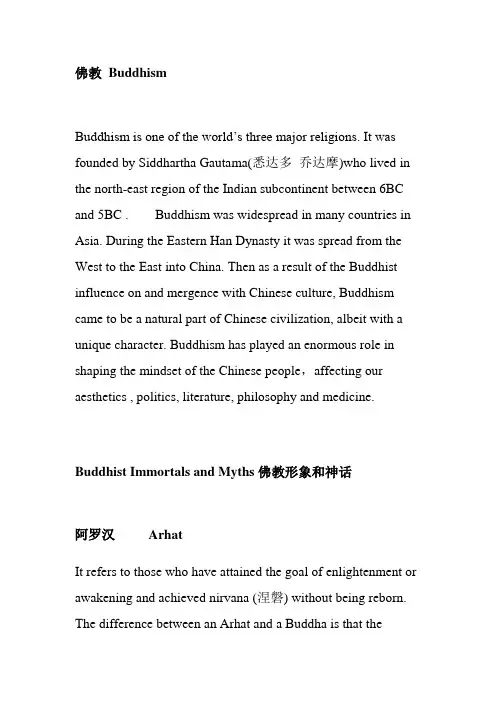
佛教BuddhismBuddhism is one of the world’s three major religions. It was founded by Siddhartha Gautama(悉达多乔达摩)who lived in the north-east region of the Indian subcontinent between 6BC and 5BC . Buddhism was widespread in many countries in Asia. During the Eastern Han Dynasty it was spread from the West to the East into China. Then as a result of the Buddhist influence on and mergence with Chinese culture, Buddhism came to be a natural part of Chinese civilization, albeit with a unique character. Buddhism has played an enormous role in shaping the mindset of the Chinese people,affecting our aesthetics , politics, literature, philosophy and medicine.Buddhist Immortals and Myths佛教形象和神话阿罗汉ArhatIt refers to those who have attained the goal of enlightenment or awakening and achieved nirvana (涅磐) without being reborn. The difference between an Arhat and a Buddha is that theBuddha attains enlightenment by himself, whereas the arhat does it by following the teachings of anther.阿弥陀佛Amitabha“Amitabha”is a Sanskrit world literally meaning boundless light and boundless life. He is the Buddha in the Land of Ultimate Bliss(极乐世界),in which all beings enjoy unbound happiness. According to the scriptures, Amitabha possesses infinite merit resulting from good deeds over countless past lives. He has forty-eight great vows to establish and adorn his Pure Land. People also recite or call upon his name by the time of dying, in the hope of being born in the Land of Ultimate Bliss with the reception by Amitabha. Amitabha is one of the most popular and well-known Buddha in China.阿弥陀佛1.jpg (241.09 KB, 下载次数: 0)。
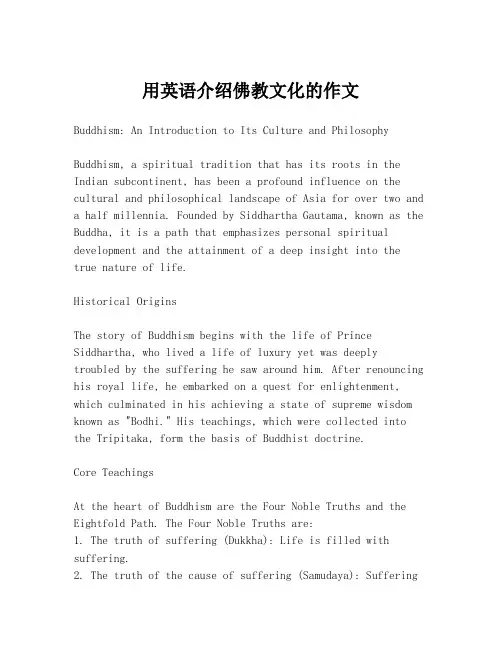
用英语介绍佛教文化的作文Buddhism: An Introduction to Its Culture and PhilosophyBuddhism, a spiritual tradition that has its roots in the Indian subcontinent, has been a profound influence on the cultural and philosophical landscape of Asia for over two and a half millennia. Founded by Siddhartha Gautama, known as the Buddha, it is a path that emphasizes personal spiritual development and the attainment of a deep insight into the true nature of life.Historical OriginsThe story of Buddhism begins with the life of Prince Siddhartha, who lived a life of luxury yet was deeply troubled by the suffering he saw around him. After renouncing his royal life, he embarked on a quest for enlightenment, which culminated in his achieving a state of supreme wisdom known as "Bodhi." His teachings, which were collected into the Tripitaka, form the basis of Buddhist doctrine.Core TeachingsAt the heart of Buddhism are the Four Noble Truths and the Eightfold Path. The Four Noble Truths are:1. The truth of suffering (Dukkha): Life is filled with suffering.2. The truth of the cause of suffering (Samudaya): Sufferingis caused by craving and attachment.3. The truth of the end of suffering (Nirodha): It ispossible to end suffering by overcoming craving and attachment.4. The truth of the path leading to the end of suffering (Magga): The Eightfold Path is the way to achieve this end.The Eightfold Path consists of right understanding, right intention, right speech, right action, right livelihood,right effort, right mindfulness, and right concentration. These practices are designed to help individuals achieve enlightenment and liberation from the cycle of rebirth knownas Samsara.Cultural ImpactBuddhism has had a significant impact on the arts, literature, and daily life in countries such as India, China, Japan, Thailand, and many others. Buddhist art, including statues of the Buddha, mandalas, and thangka paintings, often serve as a focus for meditation and are rich in symbolic meaning. Buddhist literature encompasses a vast array of texts, fromthe sutras to the philosophical treatises of various schoolsof thought.Meditation and MindfulnessCentral to Buddhist practice is meditation, which is seen asa means to calm the mind and gain insight into the nature of reality. Mindfulness, a concept that has gained popularity in the West, originates from Buddhist teachings and involvespaying close attention to the present moment without judgment.Buddhism TodayToday, Buddhism continues to evolve and adapt to modern society. It has spread beyond its Asian origins to become a global religion with millions of followers. The teachings of Buddhism offer a path to inner peace and ethical living that resonates with many in a world that is often chaotic and stressful.In conclusion, Buddhism is not just a religion but a way oflife that has provided countless individuals with a framework for understanding the world and for achieving personal transformation. Its teachings on compassion, wisdom, and the interconnectedness of all beings continue to inspire andguide those who seek a deeper understanding of life's complexities.。
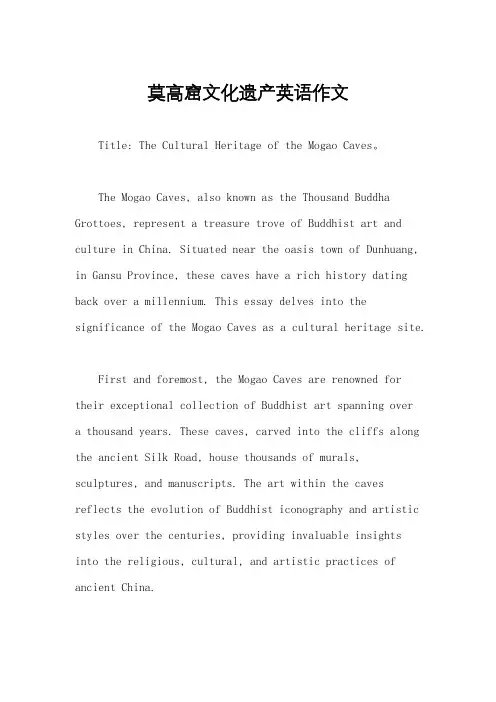
莫高窟文化遗产英语作文Title: The Cultural Heritage of the Mogao Caves。
The Mogao Caves, also known as the Thousand Buddha Grottoes, represent a treasure trove of Buddhist art and culture in China. Situated near the oasis town of Dunhuang, in Gansu Province, these caves have a rich history dating back over a millennium. This essay delves into the significance of the Mogao Caves as a cultural heritage site.First and foremost, the Mogao Caves are renowned for their exceptional collection of Buddhist art spanning overa thousand years. These caves, carved into the cliffs along the ancient Silk Road, house thousands of murals, sculptures, and manuscripts. The art within the caves reflects the evolution of Buddhist iconography and artistic styles over the centuries, providing invaluable insightsinto the religious, cultural, and artistic practices of ancient China.Moreover, the Mogao Caves serve as a testament to the cross-cultural exchange facilitated by the Silk Road. As a vital hub along this ancient trade route, Dunhuang was a melting pot of diverse cultures and religions, including Buddhism, Daoism, and Islam. The art found in the Mogao Caves bears witness to this cultural fusion, incorporating elements from Central Asia, India, and China. This cultural synthesis not only enriched the artistic repertoire of the region but also fostered mutual understanding and tolerance among different communities.Furthermore, the Mogao Caves played a pivotal role in the transmission of Buddhist scriptures and teachings. The discovery of the Dunhuang manuscripts, a vast collection of Buddhist texts, literary works, and administrative documents, shed light on the intellectual and religiouslife of medieval China. These manuscripts, hidden within the caves for centuries, provide invaluable insights into the beliefs, rituals, and everyday practices of ancient Chinese society.In addition to their artistic and historicalsignificance, the Mogao Caves hold immense spiritual importance for Buddhists around the world. Pilgrims and devotees visit these sacred sites to pay homage to the Buddha and seek spiritual enlightenment. The serene atmosphere of the caves, coupled with the awe-inspiring beauty of the murals and statues, creates a sense of reverence and tranquility that transcends time and space.However, despite their cultural significance, the Mogao Caves face numerous challenges, including environmental degradation, natural disasters, and human activities. Climate change, in particular, poses a significant threat to the preservation of the caves and their priceless treasures. Rising temperatures, increased humidity, and sandstorms accelerate the deterioration of the fragile murals and sculptures, jeopardizing their long-term survival.To address these challenges, concerted efforts are underway to conserve and protect the Mogao Caves and their cultural heritage. Conservation experts employ advanced techniques and technologies to stabilize the cavestructures, monitor environmental conditions, and prevent further deterioration of the artworks. Furthermore, initiatives aimed at raising awareness and promoting sustainable tourism seek to balance the preservation of the site with the needs of visitors and local communities.In conclusion, the Mogao Caves stand as a testament to the rich cultural heritage of China and the enduring legacy of Buddhist civilization. As custodians of this priceless treasure, it is our collective responsibility to safeguard the caves and ensure that future generations can continue to marvel at their beauty and significance. Through preservation, research, and education, we can ensure that the legacy of the Mogao Caves remains alive for centuries to come.。
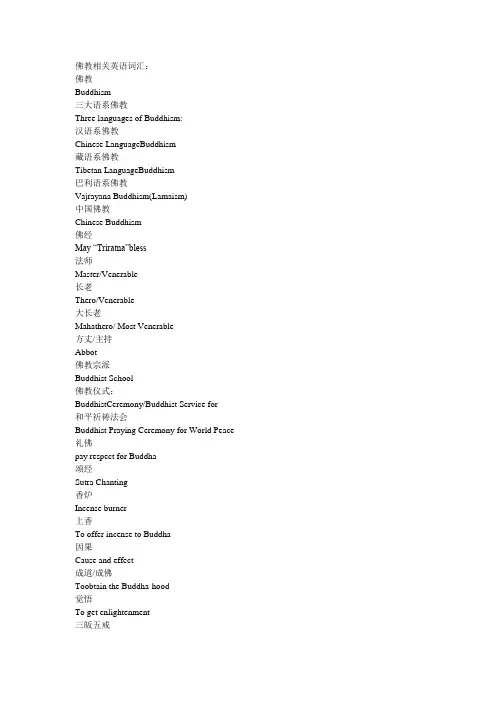
佛教相关英语词汇:佛教Buddhism三大语系佛教Three languages of Buddhism:汉语系佛教Chinese LanguageBuddhism藏语系佛教Tibetan LanguageBuddhism巴利语系佛教Vajrayana Buddhism(Lamaism)中国佛教Chinese Buddhism佛经May “Triratna”bless法师Master/Venerable长老Thero/Venerable大长老Mahathero/ Most Venerable方丈/主持Abbot佛教宗派Buddhist School佛教仪式:BuddhistCeremony/Buddhist Service for和平祈祷法会Buddhist Praying Ceremony for World Peace 礼佛pay respect for Buddha颂经Sutra Chanting香炉Incense burner上香To offer incense to Buddha因果Cause and effect成道/成佛Toobtain the Buddha-hood觉悟To get enlightenment三皈五戒The ceremony for lay Buddhists to go to the Buddha for refuge, goto the Dharma for refuge, go to the Sangha forrefuge and to follow the five commandments of Buddhism(no killing,no stealing,no sexualmisconduct,no lying,no intoxicant)诸恶莫做,众善奉行,自净其意,既是佛教“To do no evil, to do only good, to purify the will, is thedoctrine of all Buddhas”做功德To make contribution to普渡终生To save all living beings from sufferingsAmitabha 阿弥陀佛Avalokiteshvara 观音Bhodisattva 菩萨释迦牟尼佛Buddha Sakyamuni观音菩萨AvalOkiteSVaraffinities 因缘* (with emphasis on good relationships)All living beings have the Buddha-nature; all can become Buddhas. 一切众生,皆有佛性,皆堪作佛。
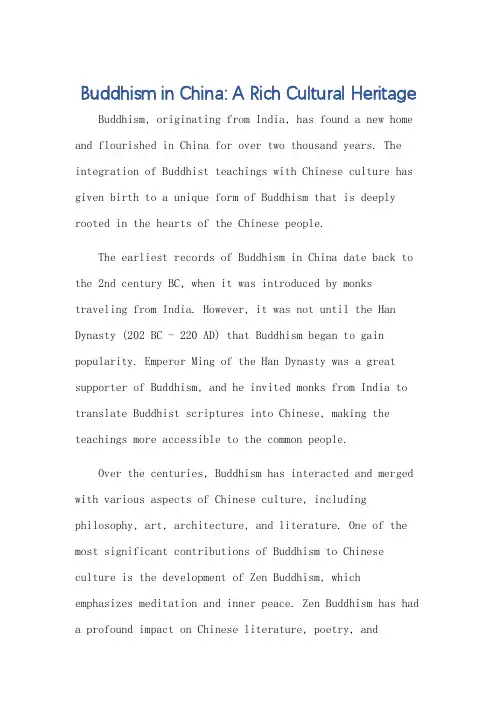
Buddhism in China: A Rich Cultural Heritage Buddhism, originating from India, has found a new home and flourished in China for over two thousand years. The integration of Buddhist teachings with Chinese culture has given birth to a unique form of Buddhism that is deeply rooted in the hearts of the Chinese people.The earliest records of Buddhism in China date back to the 2nd century BC, when it was introduced by monks traveling from India. However, it was not until the Han Dynasty (202 BC - 220 AD) that Buddhism began to gain popularity. Emperor Ming of the Han Dynasty was a great supporter of Buddhism, and he invited monks from India to translate Buddhist scriptures into Chinese, making the teachings more accessible to the common people.Over the centuries, Buddhism has interacted and merged with various aspects of Chinese culture, including philosophy, art, architecture, and literature. One of the most significant contributions of Buddhism to Chinese culture is the development of Zen Buddhism, which emphasizes meditation and inner peace. Zen Buddhism has had a profound impact on Chinese literature, poetry, andpainting, leading to the creation of numerous works that reflect the spiritual essence of Zen.Architecture is another area where Buddhism has left a lasting imprint in China. Temples and pagodas, which are symbols of Buddhist culture, can be found throughout China. These structures, often adorned with intricate carvings and painted murals, reflect the beauty and harmony of Buddhist art.In addition to its artistic and architectural contributions, Buddhism has also played a significant role in promoting moral values and social welfare in China. Many Buddhist temples and monasteries have provided education, healthcare, and relief to the needy throughout history.Today, Buddhism remains one of the major religions in China, with millions of followers. It has not only survived but also thrived in the face of various challenges and changes. The continuous development and innovation of Buddhist culture in China have ensured its relevance and popularity among the people.In conclusion, Buddhism in China is a rich cultural heritage that has shaped and influenced the country'shistory, art, and society. Its integration with Chinese culture has created a unique form of Buddhism that isdeeply rooted in the hearts of the Chinese people. As welook towards the future, it is hopeful that this beautiful tradition will continue to flourish and inspire generations to come.**中国的佛教文化:丰富的文化遗产**起源于印度的佛教,在中国已有两千多年的历史,并在这里蓬勃发展。
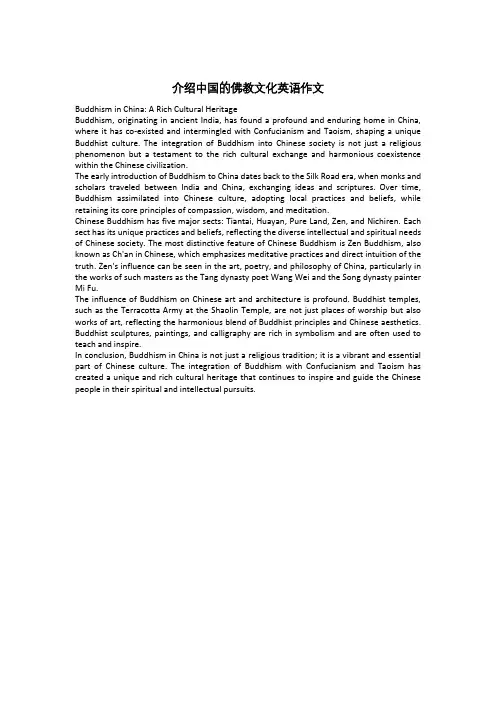
介绍中国的佛教文化英语作文Buddhism in China: A Rich Cultural HeritageBuddhism, originating in ancient India, has found a profound and enduring home in China, where it has co-existed and intermingled with Confucianism and Taoism, shaping a unique Buddhist culture. The integration of Buddhism into Chinese society is not just a religious phenomenon but a testament to the rich cultural exchange and harmonious coexistence within the Chinese civilization.The early introduction of Buddhism to China dates back to the Silk Road era, when monks and scholars traveled between India and China, exchanging ideas and scriptures. Over time, Buddhism assimilated into Chinese culture, adopting local practices and beliefs, while retaining its core principles of compassion, wisdom, and meditation.Chinese Buddhism has five major sects: Tiantai, Huayan, Pure Land, Zen, and Nichiren. Each sect has its unique practices and beliefs, reflecting the diverse intellectual and spiritual needs of Chinese society. The most distinctive feature of Chinese Buddhism is Zen Buddhism, also known as Ch'an in Chinese, which emphasizes meditative practices and direct intuition of the truth. Zen's influence can be seen in the art, poetry, and philosophy of China, particularly in the works of such masters as the Tang dynasty poet Wang Wei and the Song dynasty painter Mi Fu.The influence of Buddhism on Chinese art and architecture is profound. Buddhist temples, such as the Terracotta Army at the Shaolin Temple, are not just places of worship but also works of art, reflecting the harmonious blend of Buddhist principles and Chinese aesthetics. Buddhist sculptures, paintings, and calligraphy are rich in symbolism and are often used to teach and inspire.In conclusion, Buddhism in China is not just a religious tradition; it is a vibrant and essential part of Chinese culture. The integration of Buddhism with Confucianism and Taoism has created a unique and rich cultural heritage that continues to inspire and guide the Chinese people in their spiritual and intellectual pursuits.。
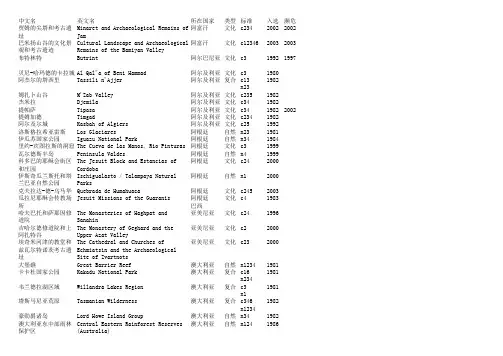
临高文庙文化遗产英语作文全文共3篇示例,供读者参考篇1The Lingao Confucian Temple: A Timeless Treasure of Culture and LearningAs a student, I have always been fascinated by the rich cultural heritage that surrounds us, particularly in the form of ancient sites and buildings that have withstood the test of time. One such place that has captured my heart and imagination is the Lingao Confucian Temple, a magnificent structure that stands as a testament to the enduring legacy of Confucianism and the profound impact it has had on Chinese society.Nestled in the heart of Lingao County, this temple is a true gem, a place where history and tradition intertwine seamlessly. Dating back to the Tang Dynasty, the Lingao Confucian Temple has weathered the storms of time, its imposing architecture and intricate carvings bearing witness to the unwavering commitment to learning and moral cultivation that has defined Chinese culture for centuries.As I step through the grand gates, I am immediately transported to a realm of tranquility and reverence. The air is thick with the scent of incense, mingling with the whispers of ancient wisdom that seem to emanate from every brick and tile. The temple grounds are a harmonious blend of nature and human artistry, with meticulously manicured gardens and serene courtyards providing a sanctuary for contemplation and study.One of the most striking features of the Lingao Confucian Temple is its magnificent halls, each adorned with exquisite carvings and intricate paintings that depict scenes from Confucian teachings and Chinese mythology. The vivid colors and intricate details are a feast for the eyes, inviting visitors to immerse themselves in the rich tapestry of Chinese culture and philosophy.As I wander through the halls, I am struck by the sense of reverence that permeates every inch of this sacred space. The air is filled with the echoes of scholars past, their voices resounding through the ages, reminding us of the enduring value of knowledge and moral cultivation. It is a place where the pursuit of wisdom is celebrated, and the ideals of benevolence, righteousness, propriety, and filial piety are upheld as the guiding principles of a virtuous life.The Lingao Confucian Temple is not merely a relic of the past, but a living embodiment of the timeless wisdom that has shaped Chinese society for centuries. It serves as a beacon of learning, attracting students and scholars from far and wide, eager to immerse themselves in the teachings of the great thinkers and philosophers who have left an indelible mark on the world.One of the most awe-inspiring aspects of the temple is its vast collection of ancient texts and manuscripts, carefully preserved and curated by generations of dedicated scholars. These priceless treasures offer a window into the minds of the great thinkers of the past, allowing us to delve into the depths of their wisdom and gain a deeper understanding of the philosophical foundations that have shaped our world.As I pore over these ancient texts, I am struck by the profound insights and timeless truths that they contain. The teachings of Confucius and his followers speak to the universal human experience, offering guidance on how to live a life of virtue, integrity, and compassion. These principles transcend time and culture, resonating with people of all backgrounds and ages.Beyond its academic and philosophical significance, the Lingao Confucian Temple also serves as a vibrant cultural hub,hosting a myriad of festivals and celebrations that pay homage to the rich tapestry of Chinese traditions. During these events, the temple comes alive with the sounds of music, the aromas of traditional delicacies, and the vibrant colors of ceremonial costumes, creating an atmosphere that is both captivating and deeply rooted in the collective memory of the Chinese people.As a student, my visits to the Lingao Confucian Temple have been transformative experiences, nurturing my intellectual curiosity and instilling in me a deep appreciation for the wisdom of our ancestors. Each time I step through its gates, I am reminded of the enduring power of knowledge, the value of moral cultivation, and the importance of preserving our cultural heritage for generations to come.The Lingao Confucian Temple stands篇2The Cultural Heritage of the Lingao WenmiaoAs a student, I have always been fascinated by the rich cultural heritage of my hometown, Lingao County. Among the many historical sites that dot this picturesque region, the Lingao Wenmiao, or Confucian Temple, stands out as a testament to the profound influence of Confucian thought on Chinese civilization.This ancient complex, with its stately architecture and serene courtyards, has been a beacon of learning and moral cultivation for centuries.The Lingao Wenmiao dates back to the Tang Dynasty, a golden age of Chinese culture and philosophy. Originally built in 628 AD, it served as a place of reverence for Confucius, the great sage whose teachings have shaped the ethical and social fabric of Chinese society. Over the centuries, the temple has undergone numerous renovations and expansions, each layer adding to its historical significance and architectural splendor.As I wander through the temple's gates, I am immediately struck by the grandeur of the main hall, where a towering statue of Confucius stands majestically, his wise gaze seemingly watching over the scholars who once gathered here. The hall's intricate carvings and vibrant colors are a testament to the artistry and craftsmanship of ancient Chinese artisans.Beyond the main hall lies a labyrinth of courtyards and buildings, each with its own unique purpose. The Xingde Hall, for instance, was once a place where scholars gathered to discuss the finer points of Confucian philosophy, their debates echoing through the centuries. The Daxue, or Great Learning, housed classrooms where students diligently studied the Analects andother Confucian classics, laying the foundation for their moral and intellectual development.As I meander through these hallowed halls, I can almost sense the presence of the countless scholars who have walked these grounds over the centuries. Their pursuit of knowledge and virtue seems to permeate the very walls, inspiring me to embrace the Confucian ideals of benevolence, righteousness, propriety, wisdom, and sincerity.One of the most fascinating aspects of the Lingao Wenmiao is the intricate system of stelae, or stone tablets, that adorn its courtyards. These stelae, carved with exquisite calligraphy, immortalize the names and achievements of scholars who excelled in the imperial examinations, a rigorous system that once governed the selection of government officials. As I run my fingers over the weathered characters, I am reminded of the immense value placed on education and moral cultivation in traditional Chinese society.Beyond its historical and architectural significance, the Lingao Wenmiao serves as a living embodiment of the enduring legacy of Confucianism. Throughout the year, the temple hosts a variety of cultural events and ceremonies, many of which are rooted in Confucian traditions. During the Qingming Festival, forinstance, locals gather to pay respects to their ancestors, a practice deeply ingrained in Confucian filial piety.As a student, I find myself drawn to the Lingao Wenmiao not only for its cultural richness but also for the profound lessons it offers. In a world often consumed by materialism and fleeting pursuits, the temple stands as a testament to the enduring value of moral cultivation, intellectual curiosity, and reverence for tradition.Walking through the temple's gates, I am transported back in time, immersed in a world where knowledge was revered, and virtue was the highest aspiration. I am reminded of the importance of humility, diligence, and respect for one's elders –values that have been the bedrock of Chinese society for millennia.Moreover, the Lingao Wenmiao serves as a powerful reminder of the importance of preserving our cultural heritage. As the world becomes increasingly globalized, it is essential that we take steps to safeguard the treasures of the past, lest they be lost to the sands of time. By learning about and appreciating sites like the Lingao Wenmiao, we not only honor our ancestors but also ensure that future generations can continue to drawinspiration from these wellsprings of wisdom and cultural identity.As I reluctantly depart the temple grounds, I carry with me a renewed appreciation for the profound legacy of Confucianism and the enduring significance of the Lingao Wenmiao. This ancient site is not merely a relic of the past but a living embodiment of the values and traditions that have shaped the very fabric of Chinese civilization. It is a reminder that true knowledge and virtue are not fleeting pursuits but lifelong journeys, and that by embracing the wisdom of our ancestors, we can navigate the challenges of the present and forge a brighter future.篇3The Lingao Confucian Temple: A Priceless Cultural GemAs a student deeply interested in history and cultural preservation, I recently had the incredible opportunity to visit the renowned Lingao Confucian Temple located in Hainan Province, China. This ancient site, steeped in tradition and cultural significance, left an indelible mark on my mind and ignited a profound appreciation for the rich heritage that has been carefully safeguarded over centuries.Nestled amidst lush greenery and towering ancient trees, the Lingao Confucian Temple stands as a testament to the enduring influence of Confucian philosophy and its pivotal role in shaping Chinese society. Dating back to the 16th century, during the Ming Dynasty, this architectural marvel has withstood the test of time, serving as a living embodiment of the timeless wisdom and moral teachings of the great philosopher, Confucius.As I stepped through the ornate gates, I was immediately transported to an era of profound intellectual and spiritual enlightenment. The meticulously preserved buildings, adorned with intricate carvings and vibrant colors, exuded an aura of reverence and scholarly pursuit. The harmonious blend of traditional Chinese architectural elements, such as the iconic upturned eaves and the intricate lattice windows, created a captivating atmosphere that beckoned me to explore further.One of the most striking features of the temple complex is the Dacheng Hall, a magnificent structure that commands respect and admiration. Adorned with exquisite wooden carvings and adorned with vibrant hues of red and gold, this hall served as the epicenter of Confucian teachings and ceremonies. As I stood in awe, gazing upon the imposing statues of Confucius and his esteemed disciples, I couldn't help but feel humbled bythe profound impact their philosophical teachings have had on the world.Beyond the architectural marvels, the Lingao Confucian Temple is a veritable treasure trove of cultural artifacts and historical relics. The well-preserved stelae, inscribed with ancient calligraphic texts and imperial edicts, offer a rare glimpse into the past, providing invaluable insights into the socio-political landscape of bygone eras. As I carefully examined these stone tablets, I was struck by the intricate artistry and the profound wisdom etched into their surfaces, a testament to the enduring legacy of Confucianism.One aspect that left a lasting impression on me was the temple's commitment to preserving and promoting the study of ancient texts and classical literature. The vast collection of books and manuscripts housed within its walls is a true scholarly haven, attracting scholars and researchers from around the world. I was fortunate enough to attend a lecture delivered by a renowned Confucian scholar, who eloquently expounded on the timeless principles of filial piety, righteousness, and virtuous conduct. Their words resonated deeply, reminding me of the enduring relevance of these teachings in our modern world.Moreover, the Lingao Confucian Temple serves as a vibrant cultural hub, hosting a myriad of traditional events and festivals throughout the year. During my visit, I had the privilege of witnessing the captivating Confucian Ritual Ceremonies, where scholars and devotees donned traditional attire and performed intricate rituals with reverence and precision. The solemn chanting of ancient texts, the rhythmic movements, and the fragrant incense created an atmosphere of spiritual transcendence, transporting me back in time to an era when Confucianism was the guiding force of Chinese society.As I reluctantly bid farewell to this extraordinary place, I couldn't help but feel a profound sense of gratitude for the dedicated individuals who have tirelessly worked to preserve this remarkable cultural heritage. The Lingao Confucian Temple stands as a living testament to the enduring wisdom of Confucianism and its profound influence on the Chinese civilization. It serves as a reminder that our past is not merely a collection of dusty artifacts but a rich tapestry woven with the threads of wisdom, tradition, and cultural identity.In a world that often prioritizes modernity and progress, the Lingao Confucian Temple serves as a beacon of hope, reminding us of the importance of preserving and cherishing our culturalroots. It is a place where the echoes of ancient teachings resonate through the centuries, reminding us of the timeless values that have shaped our collective humanity.As a student and a custodian of knowledge, I feel a deep sense of responsibility to carry the torch of cultural preservation forward. The Lingao Confucian Temple has not only enriched my understanding of Chinese history and philosophy but has also ignited within me a burning passion to protect and promote our shared cultural heritage. It is through such efforts that we can ensure that the wisdom of the past continues to enlighten and guide us into the future, fostering a deeper appreciation for our collective human experience.。
常见佛教英语佛教Buddhism三大语系佛教Three languages of Buddhism:汉语系佛教Chinese Language Buddhism藏语系佛教Tibetan Language Buddhism巴利语系佛教Pali Language Buddhism大乘佛教Mahayana Buddhism上座部佛教Theravada Buddhism金刚乘/密宗Vajrayana Buddhism(Lamaism) 中国佛教Chinese Buddhism佛经Sutra经、律、论Sutras, Vinaya, Sastra大藏经Tripitaka Sutra三宝(佛、法、僧)Triratna (Buddha, Dharma,Sangha)“三宝”加被May “Triratna”bless法师Master/Venerable长老Thero/Venerable大长老Mahathero/ Most Venerable方丈/主持Abbot佛教宗派Buddhist School佛教仪式:Buddhist Ceremony/Buddhist Service for和平祈祷法会Buddhist Praying Ceremony for World Peace礼佛pay respect for Buddha颂经Sutra Chanting香炉Incense burner上香To offer incense to Buddha因果Cause and effect成道/成佛To obtain the Buddha-hood觉悟To get enlightenment三皈五戒The ceremony for lay Buddhists to go to the Buddha for refuge, go to the Dharma for refuge, go to the Sangha for refuge and to follow the five commandments of Buddhism(no killing,no stealing,no sexual misconduct,no lying,no intoxicant)诸恶莫做,众善奉行,自净其意,既是佛教“To do no evil, to do only good, to purify the will, is thedoctrine of all Buddhas”做功德To make contribution to普渡终生To save all living beings from sufferings四谛Four noble truths八正道Eight noble paths善哉Sadhu (good or excellent)佛教寺院Monastery/Buddhist Temple山门The Front Gate大雄宝殿The Main Shrine Hall圆通殿The Hall of Universal Understanding 观音殿The Hall of Avalokitesvara Buddhisatva藏经阁The Tripitaka Sutra Pavilion罗汉堂The Hall of Arhan祖师殿The Hall of Patriarch四大天王Four deva-kings, the protectors of Buddhism韦驮Vitasoka/Vigatasoka, the protector of Buddhism斋堂Monastic Dinning Hall客堂Monastic Reception四大名山:Four holy mountains of Chinese Buddhism五台山Wutai Mountain is the Holy Place of Manjusri Buddhisattva峨嵋山Ermei Mountain is the Holy Place of Mahasthama Buddhisattva九华山Jiuhua Mountain is the holy place of Ksitigarbha Buddhisattva普陀山Putuo Mountain is the holy place of Avalokitesvara Buddhisattva佛像Buddha statue释迦牟尼佛Shakyamuni Buddha弥勒佛Maitreya Buddha迦叶佛Kasyapa Buddha阿弥陀佛Amitaba Buddha毗庐舍那佛Vairocana Buddha药师佛Bhaisajya Buddha/medicine Buddha 三世佛Buddhas of Three Periods: Kasyapa Buddha of the past Shakyamuni Buddha of the present, Maitrya Buddha of the future菩萨Buddhisattva观世音菩萨Avalokitesvara Buddhisattva菩贤菩萨Samandhabatra Buddhisattva大势智菩萨Mahasthamaprapta Buddhisattva文殊菩萨Manjusri Buddisattva地藏菩萨ksitigahba Buddhisattva善财童子Sudhana罗汉Arhan西方三圣:阿弥陀佛、观音菩萨、大势至菩萨Amitaba BuddhaAvalokitesvara Buddhisattva Mahasthamaprapta Buddhisattva达摩Budhidharma摩腾Kasyapa Matanga竺法兰Gobharana/Dharmaraksa佛学院Buddhist College僧伽Sangha僧、尼(比丘、比丘尼)monk、nun /Bhiksu, Bhiksuni方丈/主持Abbot首座Chief monk监院/当家Monastic Manger侍者Assistant中国佛教协会The Buddhist Association of China中国佛学院The Buddhist Academy of China会长President副会长Vice President秘书长Secretary General副秘书长Deputy Secretary General佛学英语词汇the Great Vehicle d大乘the Lesser Vehicle 小乘the Diamond Vehicle 金刚乘Four Noble Truths 四圣谛苦suffering集causes of suffering灭suppression of suffering道path to suppression of suffering Twelve Links in the Chain of Causation 十二因缘cycle of rebirths 轮回ignorance 惑nirvana 涅磐greed 贪hatred 嗔stupidity 痴pride 慢hesitation 疑wrong view 恶见no-soul 无我impermanence 无常sentient beings 众生deva 天human 人asura 阿修罗animal 畜牲hungry ghost 饿鬼denizen of hell 地狱morality 戒concentration 定wisdom 慧action 身speech 口consciousness 意lay Buddhists 居士novice monks 沙弥monks 比丘Five Precepts 五戒personal enlightenment 自觉universal enlightenment 觉他full enlightenment 觉满Buddha of Medicine 药师佛Buddha Maitreya 弥勒佛body of essence 法身award body 报身body of transformation 化身Four Heavenly Kings 四天王karma 因果Buddha Amitaba 阿弥陀佛Buddha of Sunlight (法身佛)毗卢遮那佛Buddha Sakyamuni 释迦牟尼佛Bodhisattva of Compassion 观音菩萨Boohisattva of Ultimate Knowledge 文殊菩萨Bodhisattva of Universal Benevolence 普贤菩萨Bodhisattva of Great Power 大势至菩萨bodhi 菩提dhyana 禅那sangha 僧团saha 娑婆五蕴five aggregates色aggregate of material body受aggregate of feelings想aggregate of perceptions行aggregate of predispositions识aggregate of consciousness简单佛学英语Birth is suffering; aging is suffering;生是苦;老是苦;sickness is suffering; death is suffering;病是苦;死是苦;association with the unpleasant is suffering; 怨憎会是苦;dissociation from the pleasant is suffering;爱别离是苦;not to get what one wants is suffering;求不得是苦;in short, attachment to the five aggregates is suffering.简言之,对五蕴的执取就是苦。
藏传佛教英文词汇藏传佛教英文词汇藏传佛教英文词汇烦恼识afflicted consciousness 阿赖耶识alaya con scious ness K u 甘露amrita dra chompa 阿罗汉arhat nshin amshe Chenrezig 观音菩萨Avalokit e svara 中阴bardo 明点bindu tig-le 菩萨bodhisattva changchub sempa 释迦牟尼Sakyamu ni 中脉central channel uma 脉轮ckakra 了义,究竟实义defi nitive meaning欲界desire realm 法,佛法dharma 法界dharmadhatu 禅修dhyana 蕴aggregate 色界form realm 无色界formless realm 四圣谛four noble truths 小乘hinayana 上座部theravadin 智慧jnana yeshe 古萨里kusulu 左脉left channel jangma 中观Madhyamaka 大手印mahamudra chagya che npo 大乘马hayana tekpa chenpo 班智达pandita 念珠mala 曼达拉man dala kyikhor 转轮胜王chakravart in ghorlo gyurpa 真言乘mantrayana 气脉nadi tsa 涅磐nirvana 波罗蜜多paramita 道path 方便道path of methods tab lam 颇瓦powa般若prajna 另U 解脱戒pratimoksa vows独觉者.缘觉者. 辟支佛pratyekabuddha 四力口行preliminary practices ngondro 三界three realms 右脉right channel roma 仪轨sadhana drubtab 三摩地samadhi ting ? ngen dzin 止、奢摩他samatha shi-ne 轮回samsara 僧伽sanga gondun 论典sastra 经典sutra do 声闻者sravaka 成就者siddha 空性emptiness sunyata tongpanyi 密续tantra gyu 如来tathagatas 伏藏师terton 伏藏法terma 深观派tradition of profound view 广行派tradition of vast conduct 三宝three jewels 活佛、祖古tulku 金冈ij 乘vajrayana 金刚杵vajra 气? 风vayu 律藏vinaya dulwa 观、毗钵舍那vipasyana hlagtong 本尊yidam 观想visualization 现观庄严论Ornament ofClear Realization 菩提道灯Lamp of the Path to Enlightment 入中论Entering into the Middle Way Madhyamkavatara 五巨宝藏Five Treasuries 知识宝藏Treasury of Knowledge 喝举密续宝藏Treasury of Kagyu Tantras 岩藏宝藏Treasury of Termas 心密宝藏Treasury of Instructions 文集宝藏Treasury of Vast Teachings 禅定修习次第Stages of Meditation 弥勒菩萨Maitreya 辩屮边论Differentiation of the Middle Way from the Extremes 大乘庄严经论Ornament of the Mahayana Sutras 究竟一乘宝性论Sublime Continuum of the Mahayana 梅纪巴Maitripa 密勒日巴Milarepa 龙树Nagarjuna 中论Knowledge of the Middle Way 中观庄严论Adornment of the Middle Way 寂护Santaraksita 寂天Santideva 入菩萨行论The Way of the Bodhisattva 解深密经Difinite Explanation of the View 心经Heart Sutra 有部、分别部Particularist Vaibhahika 经部Sutra Sautrantika 唯识Mind Only Chittamatra 中观Middle Way Madhyamaka 自空Rangtong 他空Shentong Yogacara 自续Autonomy Svatantrika 应成Consequence Prasangika 阿毗达摩Abhidharma 俱舍论Kosha 色究竟天Akanishta 阿弥陀佛Amitabha 不空成就佛Amoghasiddhi 无上密续Annuttarayoga tantra 阿阍黎Archarya 圣天Aryadeva 无著Asanga 阿底峡Atisha 处Ayatanas 比丘Bhikshu 入菩萨行论Bodhisattvacharyavatara 菩提心Bodhichitta 菩萨地bhumi 佛土Bhddha field 佛果Buddhahood 佛性Buddha nature Taghagatagarba 佛护Buddhapalita 脉轮Chakra 胜乐金刚Khorlo Demchog Chakrasamvara 月称Chandrakirti 行部Charya 圆满次第Completion stage rdzogs rim 生起次第Creation Stage utpattikrama 暗劫Dark age 陀罗尼Dhara ni 护法Dharma protector dharmapala 法界Dharmadhatu chos dbyings 法身Dharmakaya chos sku 法称Dharmakirti chos grags 胜义、究竟Dharmata chos nyid 大圆满Dzogche n mahasa ndhi 无我Egolessness bdag med 人无我Egolessness of selflessness of person pudgalanairatmya 法无我Egoless ness of selfless ness ofphe nomana dharma-n airatmya 八正道Eight fold n oble path 世间八法eight worldly concerns 空性empt in ess stong pa nyid 灌顶empowerment wang 证悟enlightment byangchub 常见eternalism rtag lta 父续Father tantra pha gyu 五无间罪five acti ons of immediate con seque nee 五方佛Five Buddha rig nga 五道five paths lam lnga 五毒five poisons dug lnga 五智five wisdoms ye shes lnga 执著fixation dzin pa 四边four extremes 四无量心four immeasurables zei meid bzhi 四圣谛four noble truths 四力忏悔four power of purificati on 冈波巴Gampopa 道次第Graded path lam rim 上师guru 串习habitual patter ns bag chags 喜金冈U Hevaja kye rdo rje 缘起、因缘in terdepe ndent orig in ati on 蒋贡康楚罗卓泰耶Jamgo n Kongrul Lodr? Thaye 俱生智jnana ye shes 噶当派Kadampa bka gdams 甘珠尔、经Kanjur bga gyur 丹珠尔、论T enjur ten jur 噶举Kagyu bka rgyud 时轮金刚Kalachakra dus khor 莲花戒Kamalashila 业karma las 噶玛噶举Karma Kagyu 噶玛巴Karmapa 三身three kayas 心要口诀教授key in structi on 窍诀pith 因札菩提国王King In drabodhi 赤松德赞Triso n Detse n 事部Kriya tantra 修心Lojong 译师lotsawa 明性luminous 明光luminosity osel 文殊师利菩萨Manjushri jam dpel 咒语mantrayana 魔mara bdud 玛尔巴Marpa 心所mental factors 母续Mother tantra 手印mudra 那若巴Naropa 六瑜伽six yogas 断见nihilism chad lta 化身nirmanakaya 宁玛、旧译Nyi ngma snying ma 二障two obscurations sgrib gnyis 口传oral transmission 不了义provisional meaning drang don 净土pure land dag zhing 让炯多杰Ra ngjung Dorje 仁波切rin poche 相对真理relative truth 净相、圣观sacred outlook dag snang 菩贤菩萨Samatabhadra kun bza ng 三昧耳E samaya dam tsig 报身Sambhogakaya long spyod rdzogs pa'I sku 七支供养seve n bra nch prayer yen lag bdum 七觉支seven limbs of awakening 毗卢七支坐seve n poi nts of meditati on posture 有所依的止sharmatha with support zhi gnasrten bcas 无所依的止sharmatha without support zhi gnas rten med 善巧、方便skillful means thabs 善逝Sugata 善悲Sugatagarbha 西方净土Sukhavati dewache n 法界体性身Svabhavakakaya n gowo nyi chi ku 度母Tara drol ma 女口来藏tathagatagarbha 三性three natures 三根本three roots tsawa sum 三乘three vehicles 帝洛巴Tilopa 自他交换法T on gle n tong len食子torma 止的禅修tra nquility mediti on 三藏tripitaka de n? sum 兜率天Tushita paradise gan dan 毗卢遮那佛、大日如来佛Vairocha na nam par nang dze 金冈U vajra dorje金刚跏趺坐vajra posture dorje chi tru ng 金刚总持Vajradhara Dorje Cha ng 金刚萨垛Vajrasattva Dorje Sempa 金刚亥母Vajravarahi Dorje Phakmo 金刚瑜伽女Vajrayogi ni Dorje Najor, Dorje Palmo善金刚dorje lekpa 金刚乘Vajrayana dorje tek pa 世亲Vasubandhu 持明Vidyadhara 见、修、行view, meditation and action tawa gompa ch?律Vinaya dul wa 法- 轮wheel of dharma chok? r 乘yana 瑜伽密续yogata ntra 瑜伽士Yogi nal yor wa 瑜伽女Yog ini yal yor ma 贤劫经Bhadrakalpa Sutra pa 国师嘉察仁波切Goshir Gyaltsab Rin poche因明学tsemaAAmitabha 阿弥陀佛Anterior Tibet 前藏一个大活佛,其庙叫祖卜寺仃surpu)Apsaras 飞天Attisha 阿底峡Avalokiteshvara 观音BBhodisattva 菩萨Bon (Black )本教(黑)Budda 佛CChapel 佛堂Circuma nbulate 转经道(v.)Circuma nbulati on 转经道Circuma nbulator 转经道的人Con sort 明妃DDaki ni 空行母Deity 明王Dipamkara 燃灯佛;宝光佛Dipamkara 宝光佛;燃灯佛Discipli naria n 铁棒喇嘛Dorje 多杰(藏文:金刚)Drakpa 和尚(藏文)Dratsang 扎仓(学校)Drepu ng 哲蚌寺Drepung Monastry 哲蚌寺(拉萨三大寺之一) Drolma 卓玛(藏文:度母)Drolma 度母(女菩萨)EEn thro neme nt 坐床 Esoteric Buddhism Exotoric Buddhism FForm 色Formless 空Ge — kor 铁棒喇嘛萨三大 Great Perfection 大园满Green Tara 绿度母Gulug ( Yellow hat ) 格鲁派Guru 上师(梵文)HHayagriva 马头明主Hin aya na 小乘Holy mou ntain 魂山Hutukta 活佛(蒙文)(最好不要用)IIn car nated lama 转世活佛JJampa 弥勒慈氏Jokha ng Temple 大昭寺 GGanden Monastry 甘丹寺(拉萨三大寺之一)密宗H 宀显宗。